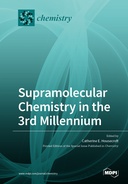Explore

Supramolecular Chemistry in the 3rd Millennium
0 Ungluers have
Faved this Work
Login to Fave
This Special Issue is one of the first for the new MDPI flagship journal Chemistry (ISSN 2624-8549) which has a broad remit for publishing original research in all areas of chemistry. The theme of this issue is Supramolecular Chemistry in the 3rd Millennium and I am sure that this topic will attract many exciting contributions. We chose this topic because it encompasses the unity of contemporary pluridisciplinary science, in which organic, inorganic, physical and theoretical chemists work together with molecular biologists and physicists to develop a systems-level understanding of molecular interactions. The description of supramolecular chemistry as ‘chemistry beyond the molecule’ (Jean-Marie Lehn, Nobel Lecture and Gautam R. Desiraju, Nature, 2001, 412, 397) addresses the wide variety of weak, non-covalent interactions that are the basis for the assembly of supramolecular architectures, molecular receptors and molecular recognition, programed molecular systems, dynamic combinatorial libraries, coordination networks and functional supramolecular materials. We welcome submissions from all disciplines involved in this exciting and evolving area of science.
This book is included in DOAB.
Why read this book? Have your say.
You must be logged in to comment.
Rights Information
Are you the author or publisher of this work? If so, you can claim it as yours by registering as an Unglue.it rights holder.Downloads
This work has been downloaded 103 times via unglue.it ebook links.
- 103 - pdf (CC BY) at Unglue.it.
Keywords
- 4-pyrrolidinopyridinium
- anion binding
- antisymmetric exchange
- bilayer membranes
- binary solid
- calixarenes
- capsules
- carboxylates
- Catalysis
- catalysis regulation
- Chirality
- chloride receptor
- chlorido ligand displacement
- chloropyrazin-2-amine
- chloropyrazine
- co-crystal
- cocrystal synthesis
- cocrystallization mechanism
- complementarity
- conformational polymorphism
- coordination cage
- Coordination Chemistry
- coordination clusters
- coordination-driven self-assembly
- copper chloride complexes
- copper complexes
- copper halide
- copper(II) complexes
- crown-ethers
- Crystal engineering
- Crystal structure
- cucurbit[7]uril
- cyclotricatechylene
- desorption kinetics
- DFT calculations
- dipolar interaction
- EPR spectroscopy
- H-bonding pattern
- halogen bond
- helicate
- Hirshfeld surfaces
- host–guest chemistry
- host–guest interaction
- Hydrogen bond
- hydrogen bonding
- hydrogen bonds
- hydroquinone
- intermolecular contacts
- ion-channels
- isotropic exchange
- Ligands
- luminescence
- magnetic susceptibility
- Manganese
- metal ions
- metal-organic frameworks
- metalla-assemblies
- metallosupramolecular
- metal–organic cage
- molecular electrostatic potential
- molecular magnetism
- molecular recognition
- molecular tecton
- multicomponent cocrystal
- n/a
- network structure
- orthogonality
- porous material
- pyrazine
- pyrazolato ligands
- pyrophosphoramide
- redox switch
- Schiff base ligands
- self-assembly
- solvatochromism
- Structure
- supramolecular assembly
- Supramolecular chemistry
- supramolecular motifs
- supramolecular structure
- switchable system
- synthons
- Technology, engineering, agriculture
- Technology: general issues
- tetrazole ligands
- uranium(VI)
- urea hydrolysis
- vapour sorption
- X-ray crystallography
- X-ray diffraction
- σ-hole
Links
DOI: 10.3390/books978-3-0365-1464-2Editions

